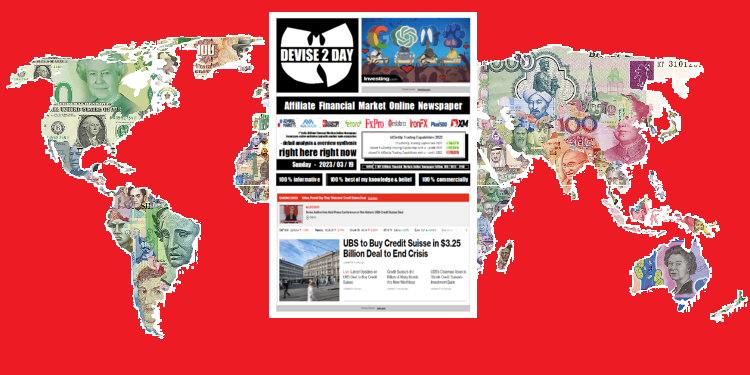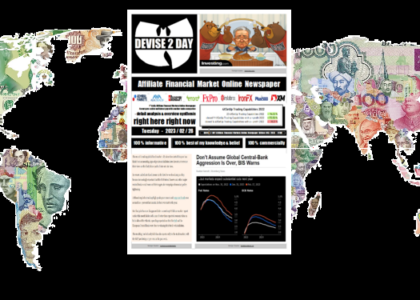
2023/03/19 (193.056) Technical Analysis – … & ICE-FX_IDC-EURUSD
Dollar Eases As Haven Demand Ebbs And/Or US10Yields Retreat Further
That`s It – Even If We`re Still In A Short NDX 4XSetUp Also Today
The Dow finished over 380 points lower on Friday, while the S&P 500 and Nasdaq 100 lost 1.1% and 0.7%, respectively, as concerns over the banking sector turmoil kept investors on edge. First Republic Bank came under renewed heavy selling pressure, down nearly 33%, as the rescue attempt from larger banks, including JPMorgan Chase and Citigroup, offered only brief relief as worries persist that the infusion may not be enough to shore up the regional bank. Also, US-listed Credit Suisse finished 7% down, even after the bank received a CHF50 billion lifeline from the Swiss National Bank. This week, the bank sector turmoil helped big techs to gain $500 billion sending Microsoft and Alphabet shares more than 12% higher. On the week, Dow Jones lost 0.4%, while the S&P 500 and Nasdaq gained 1.5% and 4.3%, respectively.
US Capacity Utilization Below Forecasts
US Manufacturing Output Unexpectedly Rises
US Industrial Output Unexpectedly Unchanged
Capacity utilization in the United States was unchanged at two-year lows of 78% in February of 2023, the same as in January, and below market forecasts of 78.4%. It is also 1.6 percentage points below its long-run average. Capacity utilization for manufacturing slipped 0.1 percentage point to 77.6%, the operating rate for mining fell 0.6 percentage point to 87.3%, while the operating rate for utilities increased 0.2 percentage point to 68.9%.
Manufacturing production in the United States increased 0.1 percent in February 2023, compared with expectations of a 0.1 percent decrease. The indexes for durable manufacturing and nondurable manufacturing moved up 0.1 percent and 0.2 percent, respectively, while the index for other manufacturing (publishing and logging) fell 1.5 percent. Within durables, computer and electronic products recorded the largest gain (1.2 percent), while nonmetallic mineral products recorded the largest loss (0.5 percent). Within nondurables, decreases of at least 1 percent were registered by textile and product mills and by plastics and rubber products; only chemicals recorded an increase of more than 1 percent. Capacity utilization for manufacturing slipped 0.1 percentage point in February to 77.6 percent, a rate that is 0.6 percentage point below its long-run average.
Industrial production in the United States was unchanged in February 2023, missing market expectations of a 0.2 percent increase after rising by 0.3 percent in January. Manufacturing output edged up 0.1 percent, compared with forecasts of a 0.1 percent decrease. The indexes for durable manufacturing and nondurable manufacturing moved up 0.1 percent and 0.2 percent, respectively, while the index for other manufacturing (publishing and logging) fell 1.5 percent. Meanwhile, mining output fell 0.6 percent while the output of utilities rose 0.5 percent. Capacity utilization was unchanged in February at 78.0 percent, a rate that is 1.6 percentage points below its long-run average.
Dollar Eases As Haven Demand Ebbs And/Or US Treasury Yields Retreat Further
The dollar index eased toward 104 on Friday, sliding for the second straight session as a rescue package for First Republic Bank eased market concerns about another bank failure in the US, lifting market sentiment while hurting demand for safe-haven currencies. Large US banks agreed to contribute $30 billion in deposits to First Republic Bank in a bid to shore up confidence in the banking system. Equities and risk-sensitive currencies rallied on the news, putting downward pressure on the dollar. The currency also weakened after the European Central Bank raised interest rates by 50 basis points despite the vulnerability of some European banks. Investors now look ahead to the Federal Reserve’s policy decision next week, where it is expected to deliver a more moderate 25 basis point rate increase in light of easing inflationary pressures and the recent banking turmoil.
The yield on the US 10-year Treasury note fell to the 3.4% mark in mid-March, the lowest in six weeks, as persistent concerns regarding the stability of the global financial sector ramped up demand for the safety of US government debt. The potential sale of the First Republic Bank extended the risk of a crisis in the banking sector after the collapse of Signature Bank and SVB. To add, the Swiss National Bank’s liquidity support for Credit Suisse offered a little relief for systemic risks to European lenders. Meanwhile, US unemployment claims figures were well below expectations in mid-March, reigniting concerns of a stubbornly tight labor market. Building permits also rose more than expected, supporting signals of a hot economy.
US Consumer Sentiment Unexpectedly Drops
The University of Michigan consumer sentiment for the US dropped for the first time in four months to 63.4 in March of 2023 from 67 in February, which was the highest reading in nearly a year, and well below forecasts of 67, a preliminary estimate showed. Overall, all components worsened relatively evenly, mainly due to persistently high prices, creating downward momentum for sentiment leading into the financial turmoil. Still, this decrease was already fully realized prior to the failure of Silicon Valley Bank. Both current conditions (66.4 vs 70.7) and expectations (61.5 vs 64.7) worsened. At the same time, inflation expectations slowed for both the year-ahead (3.8%, the lowest since April of 2021, vs 4.1%) and the five-year outlook (2.8% vs 2.9%).
However, Wall Street Under Renewed Pressure
The blue-chip Dow lost over 400 points on Friday afternoon,
while the S&P 500 and Nasdaq 100 were down 1.3% and 0.9%, respectively, as concerns about the banking sector’s health kept investors on edge.
First Republic Bank came under renewed heavy selling pressure, down more than 20%, as the rescue attempt from larger banks, including JPMorgan Chase and Citigroup, offered only brief relief as worries persist that the infusion may not be enough to shore up the regional bank. On the other side of the Atlantic, Credit Suisse declined 10% despite its recent bailout from the Swiss National Bank. On the positive side of the ledger, FedEx jumped approximately 8% after severe cost cuts helped the freight bellwether lift its profit forecast. As of Thursday’s close, the Dow Jones is up roughly 1.1% this week, while the S&P 500 and Nasdaq added 2.6% and 5.2%, respectively.
Concerns About A Stock Market Tremor On The Stock Market Is Huge, This Sunday
– The Fed And/Or The ECB, However, Expressed Extremely Satisfied With The Takeover Of Credit Suisse By The UBS
The takeover of the major Swiss bank Credit Suisse, which was completed faster than expected, is intended to strengthen investor confidence in the global banking system. It is still unclear whether this will succeed. Fed boss Powell and ECB boss Lagarde praise the government in Bern for its energy.
US Federal Reserve Chairman Jerome Powell and US Treasury Secretary Janet Yellen have welcomed the merger of the two major Swiss banks Credit Suisse and UBS. “We welcome today’s announcements by the Swiss authorities to support financial stability,” the US Treasury Department said in the evening. We are also in close contact with international partners to support their implementation. At the same time, Powell and Yellen commented on their own banks: “The capital and liquidity positions of the US banking system are strong and the US financial system is resilient.” The European Central Bank (ECB) also praised the takeover of the ailing Credit Suisse by its competitor UBS. ECB President Christine Lagarde stressed in the evening that she welcomed the rapid action and the decisions taken by the Swiss authorities. “They are critical to restoring orderly market conditions and ensuring financial stability.” According to Lagarde, the euro area banking sector is resilient and has strong capital and liquidity positions. “In any case, our policy toolbox is fully equipped to provide liquidity to the euro area financial system when needed and to ensure the smooth transmission of monetary policy,” stressed Lagarde.
The stock markets in Europe are under pressure in view of the ongoing banking crisis and the forthcoming interest rate decision by the European Central Bank (ECB). The troubled investment bank Credit Suisse is causing particular concern. While stocks and the EUR/USD currency pair fall in value, gold and the dollar index are benefiting from the growing uncertainty among investors.
EUR/USD in uptrend: trend continuation or trend reversal?
Despite modest gains this week, the future of the EUR/USD pair remains uncertain. Short-term recovery to 1.0670 and test of 1.0524 low questions uptrend. However, without a sustained break, the trend on the daily chart remains up.
ECB faced with difficult decision: rate hike or restraint?
The ECB faces a difficult choice: the previously announced 50 basis point rate hike could further depreciate the euro against the dollar, while staying at current rates exacerbates high inflation. In view of the turbulence in the banking sector, however, a key rate hike of 0.5 percentage points is becoming increasingly unlikely. The EUR/USD pair must now attempt to hold the key support at $1.0535.
good morning, good day, and/or good night
at whatever time, wherever you are !
right here right now :


















